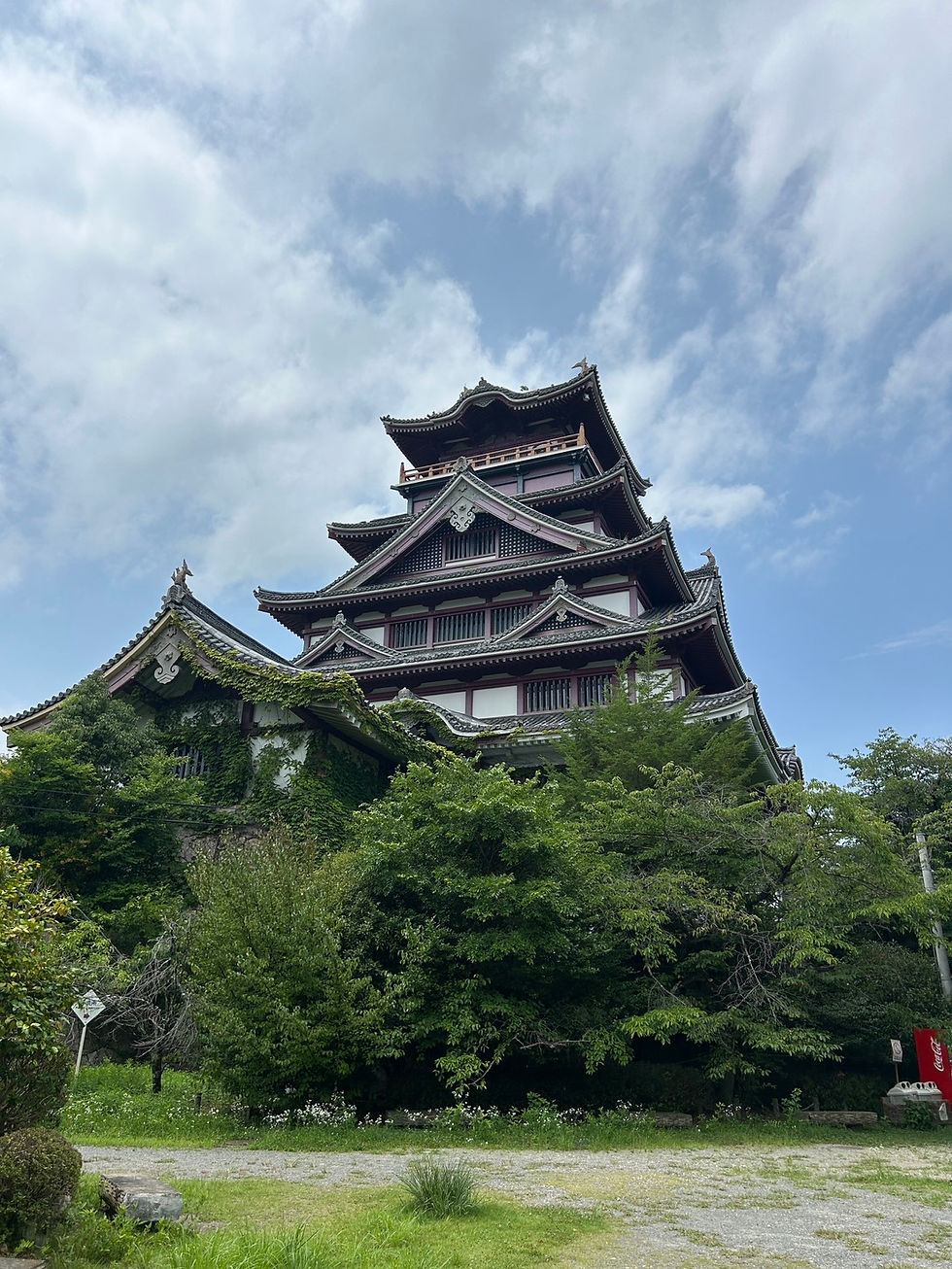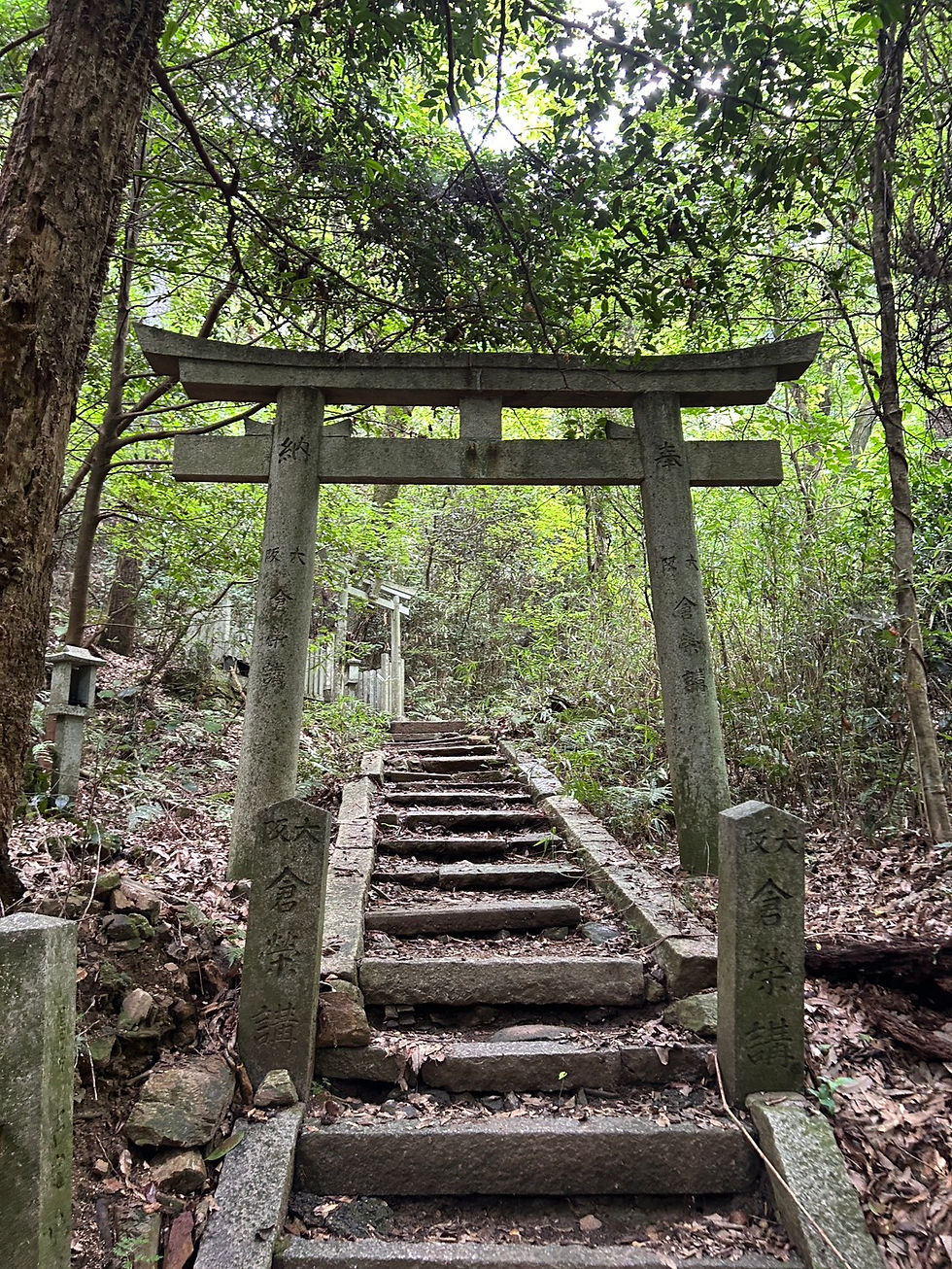HIDDEN PATHS meets Supernatural Japan Podcast Part 4 - 'From Mount Oiwa to The Grand Staircase'.
- Phillip Jackson

- Sep 23, 2025
- 4 min read
At the end of Part 3 of this 'HIDDEN PATHS - Walking Historical Kyoto' meets 'Supernatural Japan Podcast' series, a trek to some historical locations across Kyoto, some of which also have stories behind them that could well be called paranormal or supernatural, we found ourselves at the top of Mount Oiwa. In this fourth installment we descend the mount via a different route to that which we took making our ascent. The path down is a rough road, about wide enough for a small Japanese Kei car to drive along, and though cars do take this way, it is a very bumpy and uneven surface. There is not much to speak of for the most part in the journey down until we reach almost the bottom and we come to a junction. Straight ahead is where we are going, but a second, bambo forest lined route, heads off left towards Akechi Yabu. This is the location where it is said that the screaming ghost of the Samurai Akechi Mitsuhide, ambushed and killed in 1582 whilst escaping the Battle of Yamazaki after he was defeated by the army of Toyotomi Hideyoshi, can be heard on dark rainy nights, reliving his eventual downfall and earning himself the title of 'The 13 Day Shogun'! To hear about this in more detail, follow the link to view the video explanation on the Supernatural Japan YouTube channel (channel title is BusanKevin - the original YT channel of Supernatural Japan Podcast host Kevin O'Shea) - https://www.youtube.com/watch?v=GvQ9A0ROnj8&t=69s
From here we continued on, as can been seen in the picture below.

Once out of the woodland and moving away from Mount Oiwa, we walked through the residential area between Oiwa and Kitabori Park. The park was originally the north moat of the original Fushimi Castle, and next to the park is the replica castle, pictured below.

The reconstructed castle, which actually stands a few hundred metres from the location of the original castle (the original location is now the where the tomb of Emperor Meiji sits) is surrounded by an impressive garden. The original Momoyama Castle was built by Toyotomi Hideyoshi in 1594. The current reconstruction was built in 1964 and at one time housed a museum and restaurant. Sadly, entry inside the actual castle is currently prohibited as it doesn't meet current earthquake structural laws for buildings in Japan. The original castle was destroyed by an earthquake in 1596, it was quickly rebuilt and then under the control of Torii Mototada, a vassal of Tokugawa Ieyasu, the castle fell in 1600 in a famous siege by Ishida Mitsunari. Torii Mototada would commit suicide in the castle along with a number of his men and the blood stained flooring can now be found as part of the ceiling of Hosen-In Shrine in Kyoto. The castle was dismantled in 1623 and much of the building was reused in other structures across Kyoto and Japan. In 2019 Emperor Akihito visited the castle and Emperor Meiji's Tomb close by, as part of his paying of respects to the ancestors on his abdication from the throne.

From where the current castle stands we headed to the location where the original castle stood, now the site of the Tomb of emperor Meiji and the Grand Staircase. Interestingly, along the way, to the side of the wide cedar tree lined gravel route, sit many stones that were part of the original castle.

This final location has to be one of both the most impressive and under-visited locations in Kyoto. The Tomb of Emperor Meiji and The Grand Staircase. Following the gravel path route brought us to the Tomb first, at the top of the staircase, a much easier task to go down the staircase rather than up it! Emperor Meiji (1852-1912) reigned from February 3rd 1867 until his death on July 30th 1912. He presided over a period of rapid change in Japan, as the nation quickly changed from an isolationist feudal state to a capitalist and nationalistic world power. Coming to the throne as a boy in his mid-teens he was revered by the population with God-like status. He was educated in the arts and was known for the many poems that he wrote in his life-time. When Emperor Meiji passed away and departed the throne in 1912, Japan had become a very different place to the land he had known at the start of his reign. Pictured below, the Tomb of Emperor Meiji.

From the emperor's tomb we turned to face the Grand Staircase, and made our way down to the bottom. Pictured below, a selection of photos from around the tomb area, and the Grand Staircase.


'HIDDEN PATHS - Walking Historical Kyoto' - Take a guided walk with Phillip Jackson, off the beaten track and away from the crowds of central Kyoto to see a more interesting and adventurous side of the ancient capital. www.hiddenpathskyoto.com
Phillip, originally from England, has written a series of walking guidebooks covering many areas of Kyoto rarely visited by visitors to Kyoto. You can also go to the HIDDEN PATHS YouTube channel to listen to podcast interviews and radio slots https://www.youtube.com/@hiddenpaths-walkinghistori588

'SUPERNATURAL JAPAN PODCAST' - Host Kevin O'Shea introduces a mix of tales of a the supernatural, paranormal, mysterious, true crime, and the unexplained in fascinating and enthralling weekly episodes. Click on the link for Supernatural Japan episodes - https://podcasts.apple.com/us/podcast/supernatural-japan/id1616675498
Kevin, originally from Canada, is also the host of the popular Just Asia, and Just Japan podcasts. And you can find out more about Kevin's travels and experiences around Asia on his popular YouTube channel BusanKevin https://www.youtube.com/@BusanKevin/featured




Comments